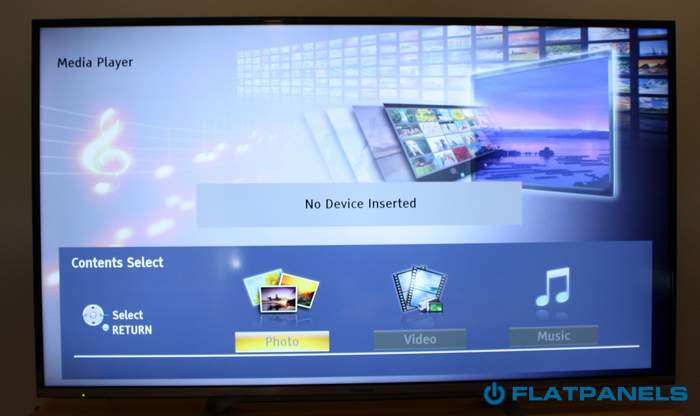Review: Panasonic AS600
Our first impressions - Test tools - Functionality - Power consumption - Calibration - Picture quality - PC & Media Center - Viewing angles - Sound - Conclusion - Debate
AS600 and AS640 are some of the few Panasonic 2014 TVs with a VA LCD panels, unlike most other midrange and high-end models that utilize IPS panels with weak contrast and blacks. AS600 is a midrange TV with the most essential TV features. It has only a few of the Smart TV features of the slightly more expensive AS640, but shares many of the same picture characteristics.
Can Panasonic continue to offer a great midrange TV market following their exit from the plasma TV market? Do they have something to replace the popular ST midrange plasma TVs? We will find out in this review.
Panasonic AS600 is only available in Europe. The AS640 uses a similar VA panel and is available in the US, too
Subscribe to our Newsletter, RSS, Facebook or twitter to receive notice when new reviews are online.Specifications
50" Full HD (1920x1080) VA LCD with edge LED Ingen 3D Stand (fixed)
Wall (VESA 400x200)(HxBxD) 65.2 x 112,6 x 5.3 cm (without stand) 15 kg HDMI (3x)
USB (2x)Optical
HDMI-ARC (1x)
HeadphonesStereo DVB T/T2/C
WiFi (n-standard)MPEG4 Smart Viera Remote control (infrared)
Smartphone app (TV Remote 2)Manual
Remote controlPrice and retailer:
Our first impressions
Despite being a midrange TV, AS600 has a very slim bezel and a thin cabinet. A few years ago you would have to buy an expensive TV to get this, but as you know high-end features tend to trickle down to cheaper products over time.The TV is not made from exclusive or quality materials, but is instead just a simple black plastic frame with a silver plastic edge that is made to resemble brushed aluminum. The stand might look like aluminum, too, but it is also made from plastic with a metal bar inside for added stability.
The TV can be wall-mounted, but unfortunately most of the input connectors point out towards the back wall, including the antenna plug, optical out, and ethernet port. The TV has 3 HDMI inputs, and these point out towards the back wall, too. Only two USB inputs are mounted on the side. This is not uncommon for midrange TVs, but it is always a bit disappointing to see.
Test tools
Our TV signal is DVB-S (satellite) from Canal Digital and DVB-T (terrestrial). Testing is done with the DVE (digital video essentials) and Peter Finzel test DVD. Testing is also done via Blu-Ray and Media center/PC.We use our own monitorTest. The software supports some of the traditional test patterns used to evaluate displays as well as some new and unique test patterns developed by the people here at FlatpanelsHD.
Sony PlayStation 3 is our Blu-Ray player.
All contrast measurements are based on the ANSI methodology.
Functionality
The remote control looks very familiar and in fact this is the same remote that Panasonic has sold for years. It is made from black plastic and feels light and fairly cheap, but is actually not different from that comes bundled with the much more expensive TVs. Panasonic’s new smart remote is only included with the more expensive Panasonic TVs.In 2014, Panasonic has introduced a new "Life+" Smart TV platform, but it is not available in the AS600. It has some of the features such as Netflix and YouTube, but several features are missing when compared to the more expensive models.
The new Netflix user interface is available through the pre-installed Netflix app, but navigation is not as smooth as on for example the PlayStation 4. AS600 supports Netflix’s Super HD (1080p) layer, but not DIAL (Chromecast) functionality.
The app store lets you download additional apps and you can also playback media from a USB hard drive or USB stick. We tried to feed it with our usual catalogue of file formats and it ate most of the traditional format and codecs, but gave up when it came to the more demanding formats such as ISO and several .mkv files.
From the Smart TV interface you have access to myStream; a horizontal stream of videos from various sources. During our review only YouTube content was available, but over time Panasonic hopes to add more sources. The underlying idea is to recommend content based on your preferences and your viewing pattern, but we only had the TV for a brief period so we cannot comment on how it works.
Another new feature is my Home Cloud that lets you upload photos and videos to a private cloud locker. You can also share content or send messages to your friends and family’s Panasonic Smart TV. We have seen it demonstrated in the past, but we continue to feel that a smartphone and tablet solves the problem in a much easier and intuitive way.
You can also connect a USB hard drive and playback USB media files such as video, music, and photos.
Besides that, AS600 is a pretty basic TV. It has a dual-core processor, so it is not the fastest TV out there and app loading times are certainly too long.
Panasonic’s menus still look like something from the 80’s. At times it can be a bit confusing to navigate the menu system, simply because the menus change appearance often.
Energy consumption
| Compare power consumption measurements on different TVs and monitors with our interactive power consumption applet here. |
 |  | |
| Standby | 0.1 W | 0.1 W |
| SD+HD | 62 W | 56 W |
Power consumption is not very high for a 50-inch TV. It is not the absolute lowest we have recorded to date, but in the good end.
Calibration of Panasonic AS600
Below are the out-of-box color measurements in the "Normal" profile.


The out-of-box picture quality is not very impressive, but Panasonic has not gone to the same extremes as some other TV makers. Colors are generally oversaturated, but the color temperature is not far from our target value. We measured brightness to 261 cd/m2 in the Normal profile, which is the highest AS600 can go.
AS600 does not offer the THX profiles of the high-end Panasonic TVs so we switched to the True Cinema profile an took a new measurement.
The True Cinema profile is much better, but not impressive either. Some color deviations remain as you can see in the graph, but we are a lot closer to our target values. Color temperature is too low, so we want to fix the color balance during calibration.
The True Cinema profile is a much better starting point, but not as accurate as the best Movies, THX or ISF profiles on more expensive TVs. Panasonic is aiming for 2.4 gamma, but you can hit 2.2 gamma by changing the gamma option in the menu.
After calibration we managed to improve color accuracy and the end result is actually quite impressive considering that we are looking at a inexpensive midrange TV here.
AS600 also offers 10 point color calibration, which is uncharacteristic for a TV in this price range. If you want to improve things even further it is possible with these settings, but we did not take advantage of them during our review as we want to share our settings with you readers. 10-point calibrations cannot be transferred from one TV to another.
| Measurements | Out-of-box | Calibrated |
|---|---|---|
| Black level | 0.05 cd/m2 | 0.03 cd/m2 |
| Brightness | 261 cd/m2 | 131 cd/m2 |
| Contrast | 5220:1 | 4367:1 |
| Input lag | - | 35 ms |
| Power consumption | Out-of-box | Calibrated |
|---|---|---|
| On | 62 W | 56 W |
| Stand-by | 0.1 W | - |
| Calibration | Setting | Value |
|---|---|---|
| General | Picture mode | Movie |
| Backlight | 52 | |
| Contrast | 90 | |
| Brightness | 0 | |
| Color | 50 | |
| Sharpness | 0 | |
| Light sensor | On/Off | |
| Advanced | Color temp | Warm2 |
| Vivid color | Off | |
| Adaptive backlight | Off | |
| Noise reduction | Off | |
| MPEG noise reduction | Off | |
| Contrast control | Off | |
| Gamma | 2.2 | |
| 16:9 Overscan | Off | |
| R gain | -2 | |
| G gain | -6 | |
| B gain | +5 | |
| R cutoff | 0 | |
| G cutoff | -1 | |
| R cutoff | -1 |
Note: The Ambient sensor option is set to On/Off in the table because it depends on your preference. Ambient Sensor is the automatic brightness adjuster that adjusts brightness according to the surroundings. The 16:9 Overscan settings is found under screen settings
Picture quality
AS600 has a semi-glossy coating on the panel, but it is not as reflective as for example Samsung’s LED models. In a brightly lit room you will see reflections from windows, but mostly during dark movie scenes.This is the first generation of TVs after Panasonic decided to abandon plasma TVs and Panasonic tells us that they have transferred know-how to their LED models. However, we do not see any significant changes compared to the 2013 line-up when it comes to scaling and reproduction of low-quality SD channels or DVD movies and we still believe that Panasonic’s plasma TVs offered a more detailed SD picture, but AS600 is not bad either.
SD scaling is roughly on par with other midrange LED models, but if you want to the best possible experience you obviously want to feed it with HD content anyways.
HD pictures look a lot better and we immediately noticed that AS600 can reproduce deep black that ensures vivid and intense HD pictures. HD picture quality is actually better than we had anticipated based on the price tag and in some ways it matches much more expensive LED models in terms of contrast.
We do not mean to suggest that it competes with a high-end LED model, but AS600 is a positive surprise. We applaud Panasonic’s choice of a VA panel instead of an IPS panel. It is one of the reasons that AS600 can offer deep blacks.
Next, we examined motion reproduction. If you are a sports fan or generally just enjoy fast-paced movies this is important. Unfortunately, AS600 has some blurring during fast motion and we also saw some mild overdrive trailing (white haloes around moving objects).
Motion reproduction is not bad, but it is not great either, and this is one area where high-end LED models outperform AS600. We do not mean to suggest that the TV is not suited for sports and action movies. It can and we are sure that it is more that good enough for most buyers, but we just want to point out that this is one area where more money will buy you a better experience.
For gaming input lag is important. On AS600 we measured input lag to 30-40 ms, which is fair, but not great. It should be low enough for most console gamers, but the goal is obviously 0 ms. Sony currently has one of the lowest levels of input lag among LCD TV makers, and we recently measured their mid-range Sony W8 - which is in the same price class as Panasonic AS600 - to just 24-28 ms.
Panasonic AS600 has no 3D function.
 |  | |
| Black level | 0.05 cd/m2 | 0.03 cd/m2 |
| Brightness | 261 cd/m2 | 131 cd/m2 |
| Contrast ratio | 5220:1 | 4367:1 |
Contrast ratio +/- 50
After calibration we measured black depth to 0.03 cd/m2, which is wildly impressive from a TV in this affordable. This is even better than Samsung’s curved high-end LED models that are also based on VA panels. In fact, this is probably the best black level we have seen from an edge LED based LCD TV.
The fact that it beats TVs that are several factors more expensive is noteworthy, but it probably says more about the state of high-end LED models than it says about a mid-range LCD TV such as the AS600.
Shadow detailing is fairly good, too. After calibration we were able to distinguish most dark grey tones, and AS600 generally does a good job at reproducing dark movie scenes because of the great black reproduction and details in dark colors.
Lastly, we examined AS600 for clouding and backlight bleeding in a completely dark room.
Our sample had some mild clouding in the corner areas of the panel, but we never noticed any issues during practical use such as movie watching with black bars. Light homogeneity is better than most edge LED models, so we cannot complain.
PC and Media Center
In order to achieve 1:1 pixel mapping you need to select "Just" from the Aspect ratio button on the remote and deactivate "16:9 overscan" from the screen settings menu.Viewing angles
Viewing angles are not great. Colors get washed out and especially red and green appears more pastel-toned from an angle. This is very typical of a VA panel and AS600 is comparable to a typical Samsung LED model. Colors start to change from around 30-35 degrees.Contrast also drops, and gets a purple tint, as you can see below.
Sound quality
The speakers are not very powerful. The bass is weak, but at least human voices are clear. Do not expect much from AS600 in this area. We recommend a separate sound solution for a better experience.Conclusion
Panasonic’s AS600 does not offer the full Smart TV experience - dubbed Life+ - of the more expensive 2014 TVs, but has the features you have come to expect from a modern TV, including USB playback and a few TV apps, including Netflix and YouTube. Not bad for an affordable TV, but you are probably better off with a streaming box such as Roku or Apple TV.On the other hand, picture quality from AS600 was a pleasant surprise. This is one of Panasonic’s few 2014 TVs with a VA-type LCD panel, which typically means good contrast and relatively deep black. And AS600 delivered exactly that. In fact, it has deeper black than even expensive high-end Full HD TVs from Samsung and Sony. It is not in the same class as these TVs on all parameters; color reproduction could have been better, but we are still impressed by how much TV you can get for your money with AS600.
As Panasonic has chosen to exit the plasma business, they have also left a void in the market. Their previous ST plasma TVs were great value-for-money TVs. AS600 is certainly not in the same class as the excellent ST plasma TVs, but we think it will turn out to be one of the best value-for-money LCD TVs of 2014 - and in many ways comparable to the Sony W8. In that light we award it our Highly Recommended Award for its midrange performance.
Price and retailer:
Picture quality is assessed as overall picture quality, including color reproduction, image processing, contrast, motion etc.
Features is an evaluation of the built-in functionality such as apps, connector ports, tuners, recording capabilities, decoder formats, and how useful they are, as well as sound quality.
User experience is evaluated on the basis of user friendliness, speed, build quality, and day-to-day use of the TV.
Total score is weighted: 50% Picture quality, 25% Features, 25% User experience.
All scores are calculated based on a moving maximum target, defined by what we currently consider the best on market. It is then presented as a percentage. This means that a score will fall over time as new and better TVs set new standards. This allows you to compare scores across years. A score of 100% in a given category means that it is consider the best available product in this category to date.
Features is an evaluation of the built-in functionality such as apps, connector ports, tuners, recording capabilities, decoder formats, and how useful they are, as well as sound quality.
User experience is evaluated on the basis of user friendliness, speed, build quality, and day-to-day use of the TV.
Total score is weighted: 50% Picture quality, 25% Features, 25% User experience.
All scores are calculated based on a moving maximum target, defined by what we currently consider the best on market. It is then presented as a percentage. This means that a score will fall over time as new and better TVs set new standards. This allows you to compare scores across years. A score of 100% in a given category means that it is consider the best available product in this category to date.
Value-for-money picture quality
Great black depth for LCD
Price
Motion reproduction not great
Input lag
Out-of-box settings
Viewing angles




















